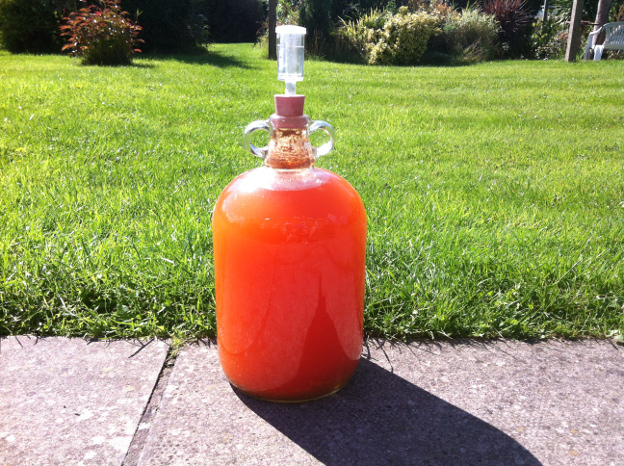Mead is actually simpler to brew than beer or wine, it doesn’t need a lot of equipment or take a lot of work, the hardest part is giving it the time it needs to thoroughly mature
To brew your own mead you will need:
A large pan (4 litres)
A standard demijohn
Bung and airlock to fit the demijohn
Pint bottle and airlock
Funnel
Siphoning tube
A thermometer
Campden tablets or similar
Bottles to put the finished mead in
3 lbs. honey
Citrus fruit – 2/3 oranges, lemon or limes
1 teaspoon yeast nutrient
1 packet champagne yeast
Water
Note – You can make your mead with cheap honey, but better honey makes better mead, if your budget doesn’t stretch to the good stuff consider making a melomel or metheglin instead to enhance the flavour.

Before you start it is important that everything is really clean, you want to remove all wild yeasts and any microscopic nasties that could ruin the taste of your mead. Use Camden tablets to make a sterilising solution and use it to sanitize all of the fermenting equipment.
The first step is to wake up the yeast – Take a pint of just boiled water, stir in a couple of tablespoons of honey or sugar and allow to cool a little. When it’s cooled to below body temperature add the yeast. Keep wild yeasts and bacteria out by transferring to the pint bottle with an airlock (you can use cotton wool or fabric if you don’t have an airlock) and leave in a warm place. After a few hours the solution should be bubbling nicely at which point you are ready to start brewing
Take enough water to fill your demijohn about two thirds full. Put this into your large pan and add the juice from the fruit and the skins to the pan, bring to the boil. Remove from the heat when it’s boiling well and stir in the honey and the yeast nutrient. Let cool to about room temperature and fish out the pieces of fruit, then add both the cooled honey water and the yeast mixture to the demijohn. Fit the airlock, using the sterilising solution to half fill the airlock with liquid, and give the demijohn a good swirl to mix the liquids. Put it somewhere warm. Within a day you should start to see bubbles coming through the airlock and a foam starting to form on top of the liquid. Now the waiting starts.
It will take a few weeks for the yeast to convert the honey to alcohol, as this happens sediment will form and sink to the bottom of the demijohn. When this gets to about an inch thick it’s a good idea to rack the mead as the sediment can add unpleasant flavours if left too long. Use the siphon to move the liquid into another sterilised demijohn (or into the large pot if you only have the one) pour away the sediment and clean the demijohn before reusing.
Top up the mead with water until it’s about an inch below the airlock and put back in the warm place. If the sediment gets to be over an inch thick again repeat the racking process. Continue until no more bubbles are forming. It usually takes two to six months to reach this point.
At this point you have mead that can be drunk, but you may not like it much. Most home brewed mead needs to mature for a while before it tastes good. Use the siphon to transfer to sterilised bottles, seal them and put them away somewhere. If you use easily resealable bottles you can have a taste every couple of months until you’re happy with it. Don’t worry if it tastes like battery acid to begin with, that is pretty normal, time will make all the difference. Six months seems to be about average for a brew to mellow into something drinkable, but it’s always worth leaving at least one bottle for over a year as sometimes that can give amazing results.
While you wait there are lots of fabulous meads you can buy and drink which will definitely make the time go faster. Our local meadery has plenty to offer and there are many other varieties available, mead seems to having a come back – huzzah!
Once you’ve mastered basic mead you can try adding herbs to the water as it boils to create a metheglin, or adding fruit for a melomel. Chilli is a great addition for a metheglin, mint, rosemary and thyme also work well. Most homemade fruit wines can be made as melomel’s simply by replacing the sugar with honey and adding yeast nutrient, elderberry always goes down well as do raspberry and blackberry. Have fun experimenting :)

